| Revision as of 13:32, 26 February 2008 view sourceClueBot (talk | contribs)1,596,818 editsm Reverting possible vandalism by 219.98.151.245 to version by 86.42.31.74. False positive? report it. Thanks, User:ClueBot. (243502) (Bot)← Previous edit | Revision as of 21:45, 26 February 2008 view source 166.217.23.4 (talk)No edit summaryNext edit → | ||
| Line 248: | Line 248: | ||
| {{main|Demographics of Honduras}}{{seealso|Hondurans}} | {{main|Demographics of Honduras}}{{seealso|Hondurans}} | ||
| According to the CIA World Factbook, Honduras has a population of 7.48 million; 90% of the population is ](, |
According to the CIA World Factbook, Honduras has a population of 7.48 million; 90% of the population is ](, 4% ], 5% ] and 1% ].<ref></ref> | ||
| ] | ] | ||
Revision as of 21:45, 26 February 2008
| This article needs additional citations for verification. Please help improve this article by adding citations to reliable sources. Unsourced material may be challenged and removed. Find sources: "Honduras" – news · newspapers · books · scholar · JSTOR (January 2008) (Learn how and when to remove this message) |
| Republic of HondurasRepública de Honduras | |
|---|---|
 Flag
Coat of arms of Honduras
Coat of arms
Flag
Coat of arms of Honduras
Coat of arms
| |
| Motto: "Libre, Soberana e Independiente" (Spanish) "Free, Sovereign and Independent" | |
| Anthem: Himno Nacional de Honduras | |
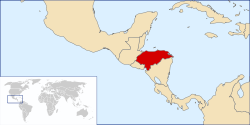 | |
| Capitaland largest city | Tegucigalpa |
| Official languages | Spanish |
| Demonym(s) | Honduran |
| Government | Presidential republic |
| • President | Manuel Zelaya |
| Independence | |
| • from Spain | 15 September 1821 |
| • from the Mexico | 1823 |
| • from the PUCA | 1838 |
| Area | |
| • Total | 112,492 km (43,433 sq mi) (102nd) |
| Population | |
| • September 2007 estimate | 7,483,763² (96th) |
| • 2000 census | 6,975,204 |
| • Density | 64/km (165.8/sq mi) (128th) |
| GDP (PPP) | 2007 estimate |
| • Total | $25.63 billion (106th) |
| • Per capita | $3,300 (124th) |
| Gini (2003) | 53.8 high inequality |
| HDI (2007) | Error: Invalid HDI value (115th) |
| Currency | Lempira (HNL) |
| Time zone | UTC-6 (CST) |
| Calling code | 504 |
| ISO 3166 code | HN |
| Internet TLD | .hn |
| |
Honduras (Template:PronEng; in Spanish, República de Honduras IPA: [onˈduɾas]) is a democratic republic in Central America. It was formerly known as Spanish Honduras to differentiate it from British Honduras (now Belize). The country is bordered to the west by Guatemala, to the southwest by El Salvador, to the southeast by Nicaragua, to the south by the Pacific Ocean at the Gulf of Fonseca, and to the north by the Gulf of Honduras, a large inlet of the Caribbean Sea.
Etymology
The Spanish used at least three different terms to refer to the area that became the Central American country of Honduras.
- Guaymuras - a name Columbus provided for a town near modern Trujillo. Bartolomé de las Casas subsequently generalized it to apply to the whole colony.
- Higueras - a reference to the gourds that come from the Jicaro tree, many of which were found floating in the waters off the northwest coast of Honduras.
- Honduras - literally "depths" in Spanish. Columbus is traditionally quoted as having written Gracias a Dios que hemos salido de esas Honduras (English: "Thank God we have come out of those depths") while along the northeastern coast of Honduras.
History
See also: History of HondurasArchaeologists have demonstrated that Honduras had a rich, multi-ethnic prehistory. An important part of that prehistory was the Mayan presence around the city of Copán in western Honduras, near the Guatemalan border. A major Mayan city flourished during the classic period (150-900) in that area. It has many carved inscriptions and stelae. The ancient kingdom, named Xukpi, existed from the fifth century to the early ninth century, with antecedents going back to at least the second century. The Mayan civilization began a marked decline in the ninth century, but there is evidence of people still living in and around the city until at least 1200. By the time the Spanish came to Honduras, the once great city-state of Copán was overrun by the jungle, and the Lencas, not the Mayans, were the main Amerindian people living in western Honduras.
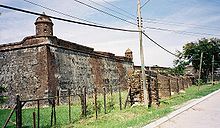
On his fourth and final voyage to the New World in 1502, Christopher Columbus reached the Bay Islands on the coast of Honduras. Landing near the modern town of Trujillo, in the vicinity of the Guaimoreto Lagoon. After the Spanish discovery, Honduras became part of Spain's vast empire in the New World within the Kingdom of Guatemala. Trujillo and Gracias were the first city-capitals. The Spanish ruled what would become Honduras for approximately three centuries. During this period a clock which had been built by the Moors in the twelfth Century was transferred to the Cathedral of Comayagua in 1636: it is now the oldest functioning clock in the Americas.

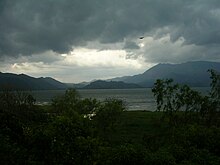

Spain granted independence to Honduras, with the rest of the Central American provinces on September 15 1821. In 1822 the United Central American Provinces decided to join the newly declared Mexican Empire of Iturbide. The Iturbide Empire was overthrown in 1823 and Central America separated from it, forming the Federal Republic of Central America, which disintegrated in 1838. As a result the states of the republic became independent nations.
Silver mining was a key factor in the Spanish conquest and settlement of Honduras, but has been only a minor part of the national economy in recent years. The American-owned Rosario Mining Company was a major gold and silver producer, but shut down its large mine at San Juancito in 1954.
Following the attack on Pearl Harbor, Honduras joined the Allied Nations on December 8, 1941. Less than a month later, on the first day of 1942, Honduras, along with twenty-five other governments, signed the Declaration by United Nations.
In 1969, Honduras and El Salvador fought what would become known as The Soccer War. There had been border tensions between the two countries after Oswaldo López Arellano, a former president of Honduras, blamed the deteriorating economy on the large number of immigrants from El Salvador. From that point on, the relationship between the two countries grew acrimonious and reached a low when El Salvador met Honduras for a three-round football elimination match as a preliminary to the World Cup. Tensions escalated, and on July 14 1969, the Salvadoran army launched an attack against Honduras. The Organization of American States negotiated a cease-fire which took effect on July 20, and brought about a withdrawal of Salvadoran troops in early August.
Contributing factors in the conflict were a boundary dispute and the presence of thousands of Salvadorans living in Honduras illegally. After the week-long football war in July 1969, many Salvadoran families and workers were expelled. El Salvador had agreed on a truce to settle the boundary issue, but Honduras later paid war damage costs for expelled refugees.
During the 1980s, the United States established a very large military presence in Honduras with the purpose of supporting the Iran-Contra Affair, anti-Sandinista Contras fighting the Nicaraguan government, and to support the El Salvador military fighting against the FMLN guerrillas. The U.S. built the airbase known as Palmerola, near Comayagua, with a 10,000-foot (3,000 m) runway so that C5-A cargo planes could land there, rather than at the public airport in San Pedro Sula. The U.S. also built a training base near Trujillo which primarily trained Contras and the Salvadoran military, and in conjunction with this, developed Puerto Castilla into a modern port. The United States built many airstrips near the Nicaraguan border to help move supplies to the Contra forces fighting the Sandinistas in Nicaragua. Though spared the bloody civil wars wracking its neighbors, the Honduran army quietly waged a campaign against leftists which included extra judicial killings and forced disappearances of political opponents by government-backed death squads, most notably Battalion 316.
Hurricane Fifi caused severe damage while skimming the northern coast of Honduras on September 18 and 19, 1974.
In 1998, Hurricane Mitch caused such massive and widespread loss that former Honduran President Carlos Roberto Flores claimed that fifty years of progress in the country were reversed. Mitch obliterated about 70% of the crops and an estimated 70-80% of the transportation infrastructure, including nearly all bridges and secondary roads. Across the country, 33,000 houses were destroyed, an additional 50,000 damaged, some 5,000 people killed, 12,000 injured, and total loss estimated at $3 billion USD.
Politics
Main article: Politics of HondurasA Presidential and General Election was held on November 27, 2005. Manuel Zelaya of the Liberal Party of Honduras (Partido Liberal de Honduras: PLH) won, with Porfirio Pepe Lobo of the National Party of Honduras (Partido Nacional de Honduras: PNH) coming in second. The PNH challenged the election results, and Lobo Sosa did not concede until December 7. Towards the end of December, the government finally released the total ballot count, giving Zelaya the official victory. Zelaya was inaugurated as Honduras' new president on January 27, 2006. His government has generally been considered fragile and he does not hold a majority in the National Congress.
Honduras has five registered political parties: PNH, PLH, Social Democrats (Partido Innovación Nacional y Social Demócrata: PINU-SD), Social Christians (Partido Demócrata-Cristiano: DC), and Democrat Unification (Partido Unificación Democrática: UD). The PNH and PLH have ruled the country for decades. In the last years, Honduras has had five Liberal presidents: Roberto Suazo Córdova, José Azcona del Hoyo, Carlos Roberto Reina, Carlos Roberto Flores and Manuel Zelaya, and two Nationalists: Rafael Leonardo Callejas Romero and Ricardo Maduro. The elections have been full of controversies, including questions about whether Azcona was born in Honduras or Spain, and whether Maduro should have been able to stand given he was born in Panama.
In 1963, a military coup was mounted against the democratically-elected president Villeda Morales and a military junta established which held power until 1981. In this year Suazo Córdova (LPH) was elected president and Honduras changed from a military authoritarian regime to an electoral democracy.
In 1986, there were five Liberal candidates and four Nationalists running for president. Because no one candidate obtained a clear majority, the so-called "Formula B" was invoked and Azcona del Hoyo became president. In 1990, Callejas won the election under the slogan "Llegó el momento del Cambio," (English "The time for change has arrived"), which was heavily criticized for resembling El Salvador's "ARENAs" political campaign. Once in office, Callejas Romero gained a reputation for illicit enrichment, and has been the subject of several scandals and accusations. It was during Flores Facusse's mandate that Hurricane Mitch hit the country and decades of economic growth were eradicated in less than a week.
Beginning in 2004, separate ballots were used for mayors, congress, and presidents; 2005 witnessed an increase in the number of registered candidates.
Although the Nationalist and Liberal parties are distinct entities with their own dedicated band of supporters, some have pointed out that their interests and policy measures throughout the twenty-five years of uninterrupted democracy have been very similar. They are often characterized as primarily serving the interests of their own members, who receive jobs when their party gains power and lose them again when the other party is elected. A common struggle for presidents is the imposition of candidates in key ministries by the unelected political leaders of their party. Both are seen as supportive of the elite that owns most of the wealth in the country, while neither extensively promotes socialist ideals. In many ways Honduras resembles a democratic version of an old socialist state, with price controls and nationalized electric and land-line telephone services.
The effect of the patronage appointments is tremendously felt in the incapacity of government departments to carry out their mandate. In an interview with Rodolfo Pastor Fasquelle, Minister of Sports & Culture and one of three 'super ministers' responsible for coordinating the ministries related to public services (security & economic being the other 2), published in Honduras This Week on July 31, 2006, it was related that 94% of the department budget was spent on bureaucracy and only 6% went to support activities and organizations covered by the mandate. Wages within that ministry were identified as the largest budget consumer. Unfortunately, many hard working and intelligent government employees end up tarnished by the broad brush strokes of this form of corruption.
President Maduro's administration "de-nationalized" the telecommunications sector in a move to promote the rapid diffusion of these services to the Honduran population. As of November 2005, there were around 10 private-sector telecommunications companies in the Honduran market, including two mobile phone companies. As of mid 2007 the issue of tele-communications continues to be very damaging to the current government. The country's main newspapers are La Prensa, El Heraldo, La Tribuna y El Tiempo.
Departments and municipalities
See also: Departments of Honduras and Municipalities of HondurasHonduras is divided into 18 departments. The capital city is Tegucigalpa Central District of the department of Francisco Morazán.
 |
National symbols


The flag of Honduras is composed of 3 equal horizontal stripes, with the upper and lower ones being blue and representing the Pacific ocean and Caribbean sea. The central stripe is white. It contains five blue stars representing the five states of the Central American Union. The middle star represents Honduras, located in the center of the Central American Union. The legislation designating this design for the flag of Honduras passed into law on January 18,1949.
The Coat of arms was established in 1825. It is one an equilateral triangle, at the base a volcano finds its base between two castles, over which we find a rainbow and the sun shining. The triangle placed on an area that supposes bathed by both seas. Around all of this an oval that it contains in golden lettering: "Republic of Honduras, Free, Sovereign and Independent".
The National Anthem of Honduras is a result of a contest carried out in 1904 during the presidency of Manuel Bonilla. In the end, it was the poet Augusto C. Coello that ended up writing the anthem, with the participation of the German composer Carlos Hartling writing the music. The anthem was officially adopted on November 15, 1915, during the presidency of Alberto Membreño. The anthem is composed of a choir and seven strophes, which report historical events of the country.
The National Flower of the Honduran is the famous orchid, Rhyncholaelia digbyana (formerly known as Brassavola digbyana), which replaced the rose in 1969. The change of the National Flower was carried out during the administration of general Oswaldo López Arellano, thinking that Brassavola Digbiana "is an indigenous plant of Honduras; having this flower exceptional characteristics of beauty, vigor and distinction", as the decree dictates it.
The National Tree of Honduras is the Pine of scientific name: Pinus hondurensis, which was approved on February 4, 1927 during the presidency of Miguel Paz Barahona. Also the use of the tree was regulated, "to avoid the unnecessary destructions caused by choppings or fires of forest."
The National Mammal is the White Tailed Deer, which was adopted on June 28, 1993 by the government of Honduras, as measurement to avoid excessive depredation. The scientific name of the animal is: Odocoileus virginianus, one of two species of deer that live in Honduras. Its feeding is based on grasses, sheets, etc. The three biggest natural enemies of the White Tail are the puma, the jaguar and man.
The National Bird of Honduras is the Scarlet Macaw (Ara macao), under a decree established in 1993. This bird, was much valued by the pre-Columbian civilizations of Honduras. The Guacamaya, as it is called by Hondurans and others, belongs to the family of the Psittacidae and his feeding consists in: nectar, roots, fruits etc. The bird lives from Bolivia up to Mexico where the bird makes use of various zones as its natural habitat. In Honduras the scarlet macaw, can be found particularly in the Mosquito Coast.
Geography


Honduras borders the Caribbean Sea on the north coast and the Pacific Ocean on the south through the Gulf of Fonseca. The climate varies from tropical in the lowlands to temperate in the mountains. The central and southern regions are relatively hotter and less humid than the northern coast.
The Honduran territory consists mainly of mountains (~81%), but there are narrow plains along the coasts, a large undeveloped lowland jungle La Mosquitia region in the northeast, and the heavily populated lowland San Pedro Sula valley in the northwest.
In La Mosquitia, lies the UNESCO-world heritage site Río Plátano Biosphere Reserve, with the Coco River which divides the country from Nicaragua.
Natural resources include timber, gold, silver, copper, lead, zinc, iron ore, antimony, coal, fish, shrimp, and hydropower.
The Islas de la Bahía and the Swan Islands (all off the north coast) are part of Honduras. Misteriosa Bank and Rosario Bank, 130 to 150 km (80-93 miles) north of the Swan Islands, fall within the EEZ of Honduras.
Economy
See also: Economy of Honduras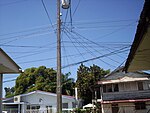

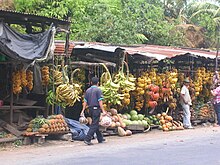
Honduras is among the 10 poorest countries in the Western Hemisphere with GDP per capita at US$3,300 per year (2007). The economy has continued to grow slowly but the distribution of wealth remains very polarized with average wages remaining very low. Economic growth in the last few years has averaged 5% a year, but 50%, approximately 3.7 million, of the population still remain below the poverty line. It is estimated that there are more than 1.2 million people who are unemployed, the rate of unemployment standing at 27.9%.
The World Bank and the International Monetary Fund classify Honduras as one of the Heavily Indebted Poor Countries eligible for debt relief, which was given in 2005.
Both the electricity services (ENEE) and land-line telephone services (HONDUTEL) have been operated by government agencies, with the ENEE receiving heavy subsidies because of chronic financial problems. HONDUTEL, however, is no longer a monopoly, the telecommunication sector having been opened to private-sector companies after December 25 2005; this was one of the requirements before approving the beginning of CAFTA. There are price controls on petrol, and other temporary price controls for basic commodities are often passed for short periods by the Congress.
After years of declining against the U.S. dollar the Lempira has stabilized at around 19 Lempiras per dollar. In June of 2007 the exchange rate between United States Dollars and Honduran Lempiras was approximately 1 to 18.89.
In 2005 Honduras signed the CAFTA (Free Trade Agreement with USA). In December 2005, Honduras' main seaport Puerto Cortes was included in the U.S. Container Security Initiative.
On December 7 2006, the U.S. Departments of Homeland Security (DHS) and Energy (DOE) announced the first phase of the Secure Freight Initiative, an unprecedented effort to build upon existing port security measures by enhancing the U.S. federal government’s ability to scan containers for nuclear and radiological materials overseas and to better assess the risk of inbound containers. The initial phase of Secure Freight involves the deployment of a combination of existing technology and proven nuclear detection devices to six foreign ports: Port Qasim in Pakistan; Puerto Cortes in Honduras; Southampton in the United Kingdom; Port Salalah in Oman; Port of Singapore; and the Gamman Terminal at Port Busan in Korea. Beginning in early 2007, containers from these ports will be scanned for radiation and information risk factors before they are allowed to depart for the United States.
Environment
Honduras is part of Mesoamerica. The region is considered a biodiversity hotspot due to the numerous plant and animal species that can be found there. Like other countries in the region, Honduras contains vast biological resources. This 43,278 square mile (112,092 km²) country hosts more than 6,000 species of vascular plants, of which 630 (described so far) are Orchids; around 250 reptiles and amphibians, more than 700 bird species, and 110 mammal species, half of them being bats.
In the northeastern region of La Mosquitia lies the Río Plátano Biosphere Reserve, a lowland rainforest which is home to a great diversity of life. The reserve was added to the UNESCO World Heritage Sites List in 1982.
Honduras has rain forests, cloud forests (which can rise up to nearly three thousand meters above sea level), mangroves, savannas and mountain ranges with pine and oak trees, and the Mesoamerican Barrier Reef System. In the Bay Islands there are bottlenose dolphins, manta rays, parrot fish, schools of blue tang and whale shark.
Infrastructure
| This article is written like a personal reflection, personal essay, or argumentative essay that states a Misplaced Pages editor's personal feelings or presents an original argument about a topic. Please help improve it by rewriting it in an encyclopedic style. (December 2007) (Learn how and when to remove this message) |
Energy
The electricity sector in Honduras is characterized by the dominance of a vertically integrated utility (except for about half of the generation capacity) called ENEE ( Empresa Nacional de Energía Eléctrica ); a failed attempt in 1994 to unbundle the sector into separate enterprises in charge of electricity generation and distribution; the increasing share of thermal generation over the past two decades; the poor financial health of the state utility ENEE; the imbalance between relatively high industrial and relatively low residential electricity tariffs; the high technical and commercial losses in transmission and distribution; and the low electric coverage in rural areas.
Key challenges in the sector are:
- How to finance investments in generation and transmission in the absence of either a financially healthy utility or of concessionary funds by external donors for these types of investments;
- How to re-balance tariffs, cut arrears and reduce commercial losses - including electricity theft - without fostering social unrest; and
- How to reconcile environmental concerns with the government's objective to build two new large dams and associated hydropower plants.
- How to improve access in rural areas.
Water supply and sanitation
Water supply and sanitation in Honduras varies greatly from urban centers to rural villages. Larger population centers generally have modernized water treatment and distribution systems, however water quality is often poor due to lack of proper maintenance and treatment. Rural areas generally have basic drinking water systems with limited capacity for water treatment. Many urban areas have sewer systems in place for the collection of wastewater, however proper treatment of wastewater is scarce. In rural areas, sanitary facilities are generally limited to latrines and basic septic pits.
Water and sanitation services were historically provided by Servicio Autonomo de Alcantarillas y Aqueductos (SANAA). In 2003, a new "water law" was passed which called for the decentralization of water services. With the 2003 law, local communities have the right and responsibility to own, operate, and control their own drinking water and wastewater systems. Since passage of the new law, many communities have joined together to address water and sanitation issues on a regional basis. what about pollution???
Many national and international non-government organizations have a history of working on water and sanitation projects in Honduras. International groups include, but are not limited to, the Red Cross, Rotary Club, Catholic Relief Services, Water for People, CARE, and SHH.
In addition, many government organizations working on projects include: the European Union, USAID, the Army Corps of Engineers, Cooperacion Andalucia, the government of Japan, and many others.
Transport
Transportation in Honduras consists of the following infrastructure: 699 km of railways; 13,603 km of roadways; 7 ports and harbors; and 112 airports altogether (12 Paved, 100 unpaved). Responsibility for policy in the transport sector rests with the Ministry of Public Works, Transport and Housing (SOPRTRAVI after its Spanish acronym).
Demographics
Main article: Demographics of HondurasSee also: HonduransAccording to the CIA World Factbook, Honduras has a population of 7.48 million; 90% of the population is Mestizo(, 4% Amerindian, 5% black and 1% white.
90% of the Honduran population is Mestizo (a mixture of Amerindian and European (predominantly Spanish) having more predominant Amerindian ancestry . About 7% of the Honduran population are members of one of the seven recognized indigenous groups. The Confederation of Autochthonous Peoples of Honduras (CONPAH) and the government of Honduras count seven different indigenous groups:
- the Ch'orti', a Mayan group living in the northwest on the border with Guatemala;
- the Garifuna speaking an Arawakan language. They live along the entire Caribbean coastline of Honduras, and in the Bay Islands;
- the Pech or Paya Indians living in a small area in the Olancho department;
- the Tolupan (also called Jicaque, "Xicaque", or Tol), living in the Department of Yoro and in the reserve of the Montaña de la Flor and parts of the department of Yoro;
- the Lenca Indians living in the Valle and Choluteca departments;
- the Miskito Indians living on the northeast coast along the border with Nicaragua.
The confederation and each separate group of indigenous people have worked, since the 1980s, for bettering the life of the aboriginal peoples. Change, however, has been elusive as these peoples still face violence and discrimination.
About 5% of Honduras's population is black, or Afro-Honduran, and mainly reside on the country's Caribbean or Atlantic coast. The black population comes from a number of sources. Most are the descendants of the West Indian islands brought to Honduras as slaves and indentured servants. Another large group (about 800,000 today) are the Garifuna, descendants of an Afro-Carib population which revolted against British authorities on the island of St. Vincent and were forcibly moved to Belize and Honduras during the eighteenth century. Garífunas are part of Honduran identity through theatrical presentations such as Louvavagu.
Honduras hosts a significant Palestinian community (the vast majority of whom are Christian Arabs). The Palestinians arrived in the country in the late 19th and early 20th centuries, establishing themselves especially in the city of San Pedro Sula. The Palestinian community, well integrated in Honduras, is prominent in business, commerce, banking, industry, and politics. There is also an East Asian community that is primarily Chinese descent, and to a lesser extent Japanese. Korean, Ryukyuan, Vietnamese also make up a small percentage due to their arrival to Honduras as contract laborers in the 1980s and 1990s. There are also an estimated 1000 Sumos (or Mayangnas) that live in Honduras, the majority of whom reside on the Caribbean coast.
Although Honduras is nominally Roman Catholic, membership in the Roman Catholic Church is declining while membership in Protestant churches is increasing. There are thriving Anglican, Presbyterian, Methodist, Seventh-Day Adventist, Lutheran, Pentacostal and Mormon churches, and they are all growing rapidly. There are Protestant seminaries. Practitioners of the Buddhist, Jewish, Islamic, Bahá'í, Rastafari and indigenous denominations and religions exist. Evangelicalism in particular is increasing in popularity.
The Church of Jesus Christ of Latter-Day Saints (Mormons) claims over 120,000 members in Honduras as of the beginning of 2007 (lds.org newsroom site).
Since 1975, emigration from Honduras has accelerated as job-seekers and political refugees sought a better life elsewhere. Although many Hondurans have relatives in Nicaragua, Spain, Mexico, El Salvador and Canada, the majority of Hondurans living abroad are in the United States.
Culture

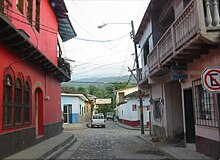
The most renowned Honduran painter is Jose Antonio Velásquez. Other important painters include Carlos Garay, and Roque Zelaya. Two of Honduras' most notable writers are Froylan Turcios and Ramón Amaya Amador. Others include Marco Antonio Rosa, Roberto Sosa, Lucila Gamero de Medina, Eduardo Bähr, Amanda Castro, Javier Abril Espinoza, and Roberto Quesada. Some of Honduras' notable musicians include Rafael Coello Ramos, Lidia Handal, Victoriano Lopez, Guillermo Anderson, Victor Donaire, Francisco Carranza and Camilo Rivera Guevara.
Hondurans are often referred to as Catracho or Catracha (fem) in Spanish. The word was coined by Nicaraguans and derives from the last name of the French Honduran General Florencio Xatruch, who, in 1857, led Honduran armed forces against an attempted invasion by North American adventurer William Walker. The nickname is considered complimentary, not derogatory.
Honduras This Week is a weekly English language newspaper that has been published for seventeen years in Tegucigalpa. On the islands of Roatan, Utila and Guanaja the Bay Islands Voice has been a source of monthly news since 2003.
Honduran cuisine makes extensive use of coconut, in both sweet and savory foods, and even in soups.
Honduras is influential in Central American music, having the first music academy in the Americas: Victoriano López. In San Pedro Sula we can find the José Francisco Saybe theater, home of Círculo Teatral Sampedrano (Theatrical Circle of San Pedro Sula).
Notable Hondurans
- Óscar Andrés Rodríguez Maradiaga, a Cardinal and potential candidate for Pope in the Papal Conclave, 2005
- Salvador Moncada is a world-renowned scientist who has authored over twelve oft-cited papers, including work on nitric oxide. His research on heart-related drugs includes the development of Viagra. Moncada works at University College London and funds an NGO in Tegucigalpa. He is married to Princess Maria-Esmeralda of Belgium
- José Antonio Velásquez is a Honduran primitivist painter, considered by many critics as the best primitivist painter in the world.
- Carlos Campos is a fashion designer, born in San Pedro Sula, notably working for big-time celebrities, who also owns two stores: one in New York and the other in San Pedro Sula
- Renán Almendárez Coello, the radio host of El Cucuy de la Mañana ("The Boogeyman of the Morning") on KLAX-FM in Los Angeles
- Carlos Mencia from Comedy Central's Mind of Mencia
- Leticia de Oyuela was a Honduran historian
- Neida Sandoval presenter of Univision morning show Despierta America in Miami
- Satcha Pretto co-host of Univision show Primer Impacto Fin de Semana in Miami
- Dunia Elvir presenter Telemundo in Los Angeles
Celebrations
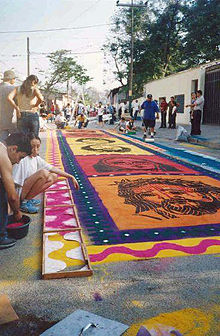
Some of Honduras's national holidays include Honduras Independence Day on September 15 and Children's Day or Dia del Niño, which is celebrated in homes, schools and churches on September 10; on this day children receive presents and have parties similar to Christmas or Birthday celebrations. Some neighborhoods have piñatas on the street. Other holidays are Easter, Maundy Thursday, Good Friday, Day of the Soldier (October 3rd to celebrate the birth of Francisco Morazán), Christmas, El Dia de Lempira on July 20, and New Year's Eve. Honduras Independence Day festivities start early in the morning with marching bands. Each band wears different colors and features cheerleaders. Fiesta Catracha takes place this same day: typical Honduran foods such as beans, tamales, baleadas, yucca with chicharron, and tortillas are offered. On Christmas Eve, the people reunite with their families and close friends to have dinner, then give out presents at midnight. In some cities fireworks are seen and heard at midnight. On New Year's Eve there is food and "cohetes" or fireworks. Birthdays are also great events, and include the famous “piñata” which is filled with candies and surprises for the children invited. La Feria Isidra is celebrated in La Ceiba in the end of May. A city located in the coast. It is usually called "The Friendship Carnaval". People from all over the world come for one week of festivities. Every night there is a little carnaval (carnavalito) in a neighborhood. Finally, on Saturday there is a big parade with floats and displays with people from Brazil, New Orleans, Japan, Jamaica, Barbados and many other countries. This celebration is also accompanied by the Milk Fair, where many Hondurans come to show of their farm products and animals.

Folklore
Honduras is a country full of folklore, its famous Lluvia de Peces (Fish Rain) being a good example. The legend of El Cadejo and La Ciguanaba (La Sucia) are also popular. Giovanni "Giovanello Von Bismarck" Bardales has played a fundamental role in the spread and development of folkloric dances in Honduras.
During the 1960s-70s and through mid 80s Honduras Radio Noticias (HRN), a local Honduran radio, was the only one which transmitted these folklore stories. The program was called "Cuentos y Leyendas de Honduras". This show was responsible for the diffusion of the folk stories in the country. The show was canceled due to low ratings but has recently been restarted.
Sports
Football, also called soccer in some countries, is the most popular sport in Honduras. Information on teams, competitions and players is available in the following articles:
- Honduras' Football Federation
- Honduras national football team
- Category:Honduran football clubs
- Category:Honduran football competitions
- Category:Honduran footballers
- Category:Football venues in Honduras
See also
Column-generating template families
The templates listed here are not interchangeable. For example, using {{col-float}} with {{col-end}} instead of {{col-float-end}} would leave a <div>...</div> open, potentially harming any subsequent formatting.
| Type | Family | Handles wiki table code? |
Responsive/ mobile suited |
Start template | Column divider | End template |
|---|---|---|---|---|---|---|
| Float | "col-float" | Yes | Yes | {{col-float}} | {{col-float-break}} | {{col-float-end}} |
| "columns-start" | Yes | Yes | {{columns-start}} | {{column}} | {{columns-end}} | |
| Columns | "div col" | Yes | Yes | {{div col}} | – | {{div col end}} |
| "columns-list" | No | Yes | {{columns-list}} (wraps div col) | – | – | |
| Flexbox | "flex columns" | No | Yes | {{flex columns}} | – | – |
| Table | "col" | Yes | No | {{col-begin}}, {{col-begin-fixed}} or {{col-begin-small}} |
{{col-break}} or {{col-2}} .. {{col-5}} |
{{col-end}} |
Can template handle the basic wiki markup {| | || |- |} used to create tables? If not, special templates that produce these elements (such as {{(!}}, {{!}}, {{!!}}, {{!-}}, {{!)}})—or HTML tags (<table>...</table>, <tr>...</tr>, etc.)—need to be used instead.
Bibliography
- Adventures in Nature: Honduras; James D. Gollin
- Don't Be Afraid, Gringo: A Honduran Woman Speaks From The Heart: The Story of Elvia Alvarado; Medea Benjamin
- Honduras: The Making of a Banana Republic; Alison Acker
- Honduras: State for Sale; Richard Lapper, James Painter
- Inside Honduras; Kent Norsworthy and Tom Berry
- La Mosquitia: A Guide to the Savannas, Rain Forest and Turtle Hunters; Derek Parent
- Moon Handbooks: Honduras; Christopher Humphrey
- Reinterpreting the Banana Republic: Region and State in Honduras, 1870-1972; Dario A. Euraque
- Seven Names for the Bellbird: Conservation Geography in Honduras; Mark Bonta
- Ulysses Travel Guide: Honduras; Eric Ilamovitch
- The United States in Honduras, 1980-1981: An Ambassador's Memoir; Jack R. Binns
- The War of the Dispossessed: Honduras and El Salvador, 1969; Thomas P. Anderson
References
- Environmental - Archeological Investigations in the Bay Islands, Spanish Honduras
- Columbus's quote
- Honduras History
- ^ "Wars of the World: Soccer War 1969". OnWar.com. Retrieved 2007-08-21.
{{cite news}}: Cite has empty unknown parameter:|coauthors=(help) - "A survivor tells her story" baltimoresun.com, June 15, 1995, retrieved January 8, 2007.
- USGS Hurricane Mitch Program -Honduras
- [http://www.laprensa.hn/ediciones/2007/08/11/que_nadie_se_atreva_a_intentar_romper_el_orden_constitucional Que nadie se atreva a intentar romper el orden constitucional]
- CIA - The World Factbook - Honduras
- web.worldbank.org
- Ports in CSI - CBP.gov
- DHS: DHS and DOE Launch Secure Freight Initiative
- CIA - The World Factbook - Honduras
- CIA - The World Factbook - Honduras
- CIA - The World Factbook - Honduras
- CIA - The World Factbook - Honduras
- Honduras This Week Online June 1999
External links
- Government of Honduras Template:Es icon
- Honduran Biodiversity Database
- Template:Dmoz
- Template:Wikitravel
- Honduras, an external wiki
| Geographic locale | |||||||||||||||||||||||
|---|---|---|---|---|---|---|---|---|---|---|---|---|---|---|---|---|---|---|---|---|---|---|---|
|
Template:Countries of Central America
| |||||||||||||||||||||||
| International membership | |
|---|---|
| Template:Latin Union |